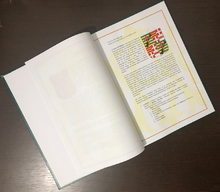Almanac of Vetrolin
 The Almanac of Vetrolin 2022 cover | |
| Original title | Portuguese: Almanaque de Vetrolin |
|---|---|
| Country | |
| Language | Portuguese |
| Genre | Nobility, heraldry, genealogy |
| Publisher | Conference of Santiago |
| Published | 2023 |
| Published in English | 2023 |
| Media type | |
| No. of books | 1 |
The Almanac of Vetrolin (Portuguese: Almanaque de Vetrolin) is a directory of micronational royalty and higher nobility, as well as statistical data by country. Heavily inspired by the Almanach of Gotha,[1][2] its first edition was published in 2023, printed in Persenburg, Karnia-Ruthenia on behalf of the Comitee of Patronage, which was assembled in 2021 from members of the Conference of Santiago, from which the initiative started. Following in the footsteps of its non-micronational counterpart, the Almanac of Vetrolin aims to be regarded as an authority in the classification of monarchies and their courts, reigning and former dynasties, princely and ducal families, and the genealogical, biographical and titulary details of micronational highest level of aristocracy. New editions of the Almanac are scheduled to be published, with more additions, but no dates have been set for their continuation.
History
Background
The idea for a micronational version of the famous Almanac of Gotha appeared several times in the micronational community. The most successful attempt at creating a micronational Gotha was the Micronational Almanach of Gotha, whose initiative was chaired by the government of the Principality of Aigues-Mortes in collaboration with the short-lived Diarchy of Sparta. After the establishment of the Secretariat of Culture of the Conference of Santiago (CS) in 2020, representatives of the member states of the organization agreed to carry out a cultural endeavor that went beyond the borders and area of influence of the CS. The Secretary of Culture at the time, Lucas VIII, Prince of Woenstein, proposed the creation of a compilation of micronational royalty and nobility that, consequently, would bring attention to CS, which was showing its first signs of ascension in the global intermicronational scenario. For this purpose, a Patronage Committee was established with Stadhouder of Mauritia as Honorary Chairman. The Emperor Oscar I of Karnia-Ruthenia was appointed Chairman of the Committee, the King Arthur II of Ebenthal as Vice-Chairman, and the other members of the committee were the King Thomas I of Quinta Velha, the Queen Maria I of Sildavia and the Emperor Leonardo I of Villa Alicia.
Publication

With the establishment of the Patronage Committee, its members collected information about the houses and families that accepted or volunteered to participate in the Almanac project. During this process, however, the project faced a freeze in its activities with the sudden death of João I, Prince of Noronha, who was not only one of the most famous micronationalists of Brazilian origin in his home country, but also a personal friend of most of the committee members. Before his death he had been responsible for editing the Almanac which, when published, was dedicated to his memory. The Karno-Ruthenian monarch personally took over the editing and formatting of the book, which was ready on 31 June 2021. The Almanac draws its name from the Mauritiaanse city of Vetrolin. The first printed edition of the book, however, was only ready in 13 January 2023, and already contained obsolete information; the births of Princess Adda of Quinta Velha and Prince Jacopo of Flandrensis were not mentioned. The preface was written by Johannes I, Prince of Armatia. The publication of Vetrolin's Almanac was formally announced on video by Emperor Oscar I of Karnia-Ruthenia.[3] The original printed edition of the Almanac was sent by him to Lucas VIII, the Stadhouder of Mauritia, who was the main patron of its realization.
Criteria
Aiming to become the most influential publication on micronational aristocratic genealogy, modeled on and in reverence to the Alamanac of Gotha, the Almanac of Vetrolin was developed through a meticulous work of unique care, bringing together an unprecedented number of royal and noble micronational houses and effectively becoming the most relevant record of aristocratic micronational families.
All dynasties included in the first edition of Almanac of Vetrolin were made with the due permission of their heads, who were invited to participate in the project, which nevertheless remains open to all who wish to participate, provided that all royal and noble houses included are able to prove their legitimacy and the origin of their dynastic claims. Once this is done, the houses are presented in order of seniority in different sections of the Almanac: reigning, mediated, deposed, extinct and prominent houses that may or not be pertain to member states of the Conference of Santiago.
Once a dynasty, either invited or applying for participation, are approved by the Committee of Patronage, they must provide information such as their membership, history, titles, and arms. Each house has as many almanac pages dedicated to it as necessary in order to expose as much essential information as possible.
Structure

As it is the practice of the diplomatic corps to employ official titles, to adhere to local precedence and etiquette, and to tender congratulations and condolences to members of the dynasty of the nation to which they were assigned, the almanac includes a Calendrier des Diplomates (Diplomats' Calendar) section, which detailed major styles and abreviations, lists of heads of state and national honors.
Families that ceased to be included for other reasons, such as lack of proof of a family's legitimate descendants or the discovery that it did not hold a valid title, were omitted. As of the first edition of the Almanac, one royal family previously included during the conception of the book, has been removed, although it remains mentioned in the summary.
Deposed sovereigns and dynasties continued to be accorded their former titles and rank, but dates of deposition were noted, and titles exclusively associated with sovereignty (e.g. emperor, queen, grand duke, crown princess) were not accorded to those who had not borne them during the monarchy. Titles of pretence below sovereign rank were accorded to members of formerly reigning dynasties as reported by heads of their houses, otherwise self-assumed titles were not used. The almanac included an explicit disclaimer announcing that known historical details of the families.
Inscribed houses
Reigning houses


 House of Götzö-Thomaz-Rocha[a]
House of Götzö-Thomaz-Rocha[a]
 House of Bruyn (listed as House of Brum)[b]
House of Bruyn (listed as House of Brum)[b]
 House of Sildavia (listed as House of Ottokar-Flaviano)[c]
House of Sildavia (listed as House of Ottokar-Flaviano)[c]
 House of Lamburg[d]
House of Lamburg[d]
 House of Woenstein
House of Woenstein House of Elphberg
House of Elphberg House of Shelby
House of Shelby House of Mersch d’Oyenberghe
House of Mersch d’Oyenberghe House of Lis
House of Lis House of Castro-Bourbon
House of Castro-Bourbon House of Grinch
House of Grinch House of Albuquerque-Baranda
House of Albuquerque-Baranda House of Souza-Marques
House of Souza-Marques House of Merchadou
House of Merchadou House of Touzeau
House of Touzeau House of Kârjasary
House of Kârjasary House of Sancratosia
House of Sancratosia House of e la Voye-Boulanger-Legendre
House of e la Voye-Boulanger-Legendre House of Sena e Albuquerque (listed as House of Karacsony-Maryen-Saena)[e][f]
House of Sena e Albuquerque (listed as House of Karacsony-Maryen-Saena)[e][f] House of Boskedale
House of Boskedale House of Scherer-Arrais[g]
House of Scherer-Arrais[g] House of Bekbulatov (listed as House of House of Tezdzhan-Smahin)
House of Bekbulatov (listed as House of House of Tezdzhan-Smahin)
Noble houses
 House of Hochbach-Kundarheim
House of Hochbach-Kundarheim House of Fejes
House of Fejes House of Callahan
House of Callahan House of Marx[h]
House of Marx[h] House of Albuquerque
House of Albuquerque House of Zeni zu Waidbruck und Frenten[i]
House of Zeni zu Waidbruck und Frenten[i] House of Beato
House of Beato
Deposed houses
 House of Hartmann-Peters[j]
House of Hartmann-Peters[j] House of Degani
House of Degani House of Kürzung[k]
House of Kürzung[k] House of Almeyda-Martins[l]
House of Almeyda-Martins[l]
Excluded houses
 House of Roy[m]
House of Roy[m]
Notes
- ↑ Also a current noble house in Ebenthal
- ↑ Also a current noble house in Karnia-Ruthenia
- ↑ Also a current noble house in Ebenthal
- ↑ Also a current noble house in Karnia-Ruthenia
- ↑ Also a current noble house in Karnia-Ruthenia
- ↑ Also a current noble house in Ebenthal
- ↑ Also a current noble house in Ebenthal
- ↑ Also a former noble house in the North American Confederation
- ↑ Also a former noble house in Petroburg
- ↑ Also a current noble house in Karnia-Ruthenia
- ↑ Also a current noble house in Karnia-Ruthenia
- ↑ Also a current noble house in Karnia-Ruthenia
- ↑ Removed following diplomatic crisis involving the CS
References
- ↑ James, John (1 April 2018). Almanach de Gotha 2018, Volume I. London: Almanach de Gotha. p. 1366. ISBN 978-0-9933725-6-8. http://www.gotha1763.com.
- ↑ "Almanach de Gotha". Justus Perthes. Retrieved 9 June 2008.
- ↑ Karnia-Ruthenia. "Apresentação do Almanaque de Vetrolin | Presentation of the Almanach of Vetrolin" Published on 13 January 2023. Retrieved on 25 July 2023.